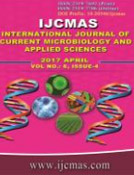


 National Academy of Agricultural Sciences (NAAS)
National Academy of Agricultural Sciences (NAAS)

|
PRINT ISSN : 2319-7692
Online ISSN : 2319-7706 Issues : 12 per year Publisher : Excellent Publishers Email : editorijcmas@gmail.com / submit@ijcmas.com Editor-in-chief: Dr.M.Prakash Index Copernicus ICV 2018: 95.39 NAAS RATING 2020: 5.38 |
The impact of mountain cropping systems on soil properties, nutrient availability and soil carbon sequestration potential was studied during the years 2014 and 2015 in mid-hills of Himachal Pradesh. The four commonly occurring cropping systems namely vegetable, fruit, cereal crop and agroforestry were selected. Barren land in the region was considered as control. In total, there were five treatments which were replicated six times under randomized block design. The study indicated that the mountain cropping systems varied significantly (p<0.05) with respect to their impact on soil properties, nutrient availability and carbon sequestration potential. The pH and EC was in the range of 6.30 to 6.95 and 0.58 to 0.66 dSm-1, respectively and were in normal range. Soil organic carbon and bulk density in surface soil ranged from 0.83 to 1.75% and 1.25 to 1.27 Mg m-3, respectively. The status of NPK was also noticed to vary among the cropping systems. Available nitrogen was highest in vegetable (555.45 kg ha-1) while available phosphorous and potassium were highest in fruit cropping system with respective values of 43.96 and 451.12 kg ha-1. Carbon density in surface soil ranged from 10.71 to 20.60 Mg C ha-1 and total carbon sequestered up to 30cm depth ranged from 1021.52 to 9395.66 Gg. The study indicated that in mid-hills of Himachal Pradesh, the commonly occurring cropping systems did not influence the soil properties and nutrient availability adversely. Fruit based cropping system was noticed to have the highest potential of sequestering soil carbon in the region. Therefore to adapt to changing climatic situation and to mitigate its effect in the region, fruit based cropping system need to be encouraged.
 |
 |
 |
 |
 |